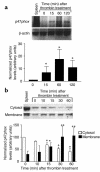p47phox is required for atherosclerotic lesion progression in ApoE(-/-) mice
- PMID: 11714743
- PMCID: PMC209414
- DOI: 10.1172/JCI11927
p47phox is required for atherosclerotic lesion progression in ApoE(-/-) mice
Abstract
NADPH oxidase is upregulated in smooth muscle cells (SMCs) in response to growth factor stimulation, concomitant with increased reactive oxygen species (ROS) production. We investigated the role of ROS production by NADPH oxidase in SMC responses to growth factors and in atherosclerotic lesion formation in ApoE(-/-) mice. SMCs from wild-type, p47phox(-/-), and gp91phox(-/-) mice differed markedly with respect to growth factor responsiveness and ROS generation. p47phox(-/-) SMCs had diminished superoxide production and a decreased proliferative response to growth factors compared with wild-type cells, whereas the response of gp91phox(-/-) SMCs was indistinguishable from that of wild-type SMCs. The relevance of these in vitro observations was tested by measuring atherosclerotic lesion formation in genetically modified (wild-type, p47phox(-/-), ApoE(-/-), and ApoE(-/-)/p47phox(-/-)) mice. ApoE(-/-)/p47phox(-/-) mice had less total lesion area than ApoE(-/-) mice, regardless of whether mice were fed standard chow or a high-fat diet. Together, these studies provide convincing support for the hypothesis that superoxide generation in general, and NADPH oxidase in particular, have a requisite role in atherosclerotic lesion formation, and they provide a rationale for further studies to dissect the contributions of ROS to vascular lesion formation.
Figures








Comment in
-
Out, damned dot: studies of the NADPH oxidase in atherosclerosis.J Clin Invest. 2001 Nov;108(10):1423-4. doi: 10.1172/JCI14453. J Clin Invest. 2001. PMID: 11714732 Free PMC article. No abstract available.
References
-
- Steinberg D. Role of oxidized LDL and antioxidants in atherosclerosis. Adv Exp Med Biol. 1995;369:39–48. - PubMed
Publication types
MeSH terms
Substances
Grants and funding
LinkOut - more resources
Full Text Sources
Other Literature Sources
Molecular Biology Databases
Miscellaneous

